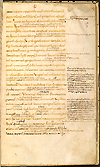The Many Uses of Books and Texts
Work of art, vehicle of knowledge, repository of ancient legacy, laboratory of new knowledge—the medieval medical book was all of those things, and more. It was the medium through which the classical Greek heritage—reworked, rearranged and re-elaborated—was received and assimilated into the West. Reproducing previous science and blending different components into a new and original synthesis, the medieval medical book embodied the new knowledge of the time. As such, it reflected daily life, revealed through the selection of texts, the layout of pages, its pictures and binding, the notes added in the margins, and the many markings that trace its use.
The medieval medical book was used as a teaching tool, as well as for personal study, and the daily exercise of medicine. Very often, it was the repository of experiences gained in medical practice, and contributed to the making of a new tradition that not only relied on textual and scholarly knowledge, but also associated theoretical science and practical experience.
Teaching
Study
![Manuscript E 3, f. 45 recto. Aristotle, De natura animalium agrestium et marinorum (On the nature of earth and see animals). [England, 13th century]. F. 45 recto from Manuscript E 3. A two column hand written page.](images/NLM22t.jpg)
Manuscript E 3, f. 45 recto
Practice
Repository of Knowledge
Last Reviewed: May 2, 2012



![Manuscript E 78, f. 19 verso. Hunayn Ibn Ishaq al-cIbadi (809–873), Isagoge. [Paris, 13th century]. F. 19 verso from Manuscript E 78. A hand written page, with an illustrated M in the left side of the middle of the page. There are three tonsured figures, the center one holds a book open while the ones to the left and right are counting off fingers.](images/NLM35t.jpg)
![Manuscript E 78, f. 32 verso. Hunayn Ibn Ishaq al-cIbadi (809–873), Isagoge. [Paris, 13th century]. F. 32 verso from Manuscript E 78. A hand written page with an illustrated O on the left side of the middle of the page. In the center of the O is a tonsured teacher holding a book with an untonsured student.](images/NLM48t.jpg)
![Manuscript E 78, f. 61 recto. Hunayn Ibn Ishaq al-cIbadi (809–873), Isagoge. [Paris, 13th century]. F. 61 recto from Manuscript E 78. A hand written page with an illustrated box on the left side of the top of the page. In the center of the box is a tonsured teacher on elaborate chair speaking to three tonsured students.](images/NLM49t.jpg)
![Manuscript E 78, f. 32 recto. Hunayn Ibn Ishaq al-cIbadi (809–873), Isagoge. [Paris, 13th century]. F. 32 recto from Manuscript E 78. A hand written page with an illustrated box on the left side of the middle of the page. In the center of the box is the letter 0. Within the letter O is a tonsured figure reading from book, untonsured patient in bed.](images/NLM55t.jpg)

![Manuscript E 12, f. 11 recto. Constantine the African, De medicina physicae artis. [Italy?, 13th century]. F. 11 recto from Manuscript E 12. A hand written manuscript page with annotations in the right margin.](images/NLM4t.jpg)
![Manuscript E 12, f. 13 recto. Constantine the African, De medicina physicae artis. [Italy?, 13th century]. F. 13 recto from Manuscript E 12. A hand written manuscript page with annotations in the right margin.](images/NLM9t.jpg)